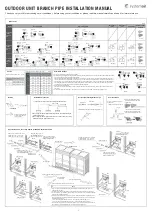
5284792-UIM-D-1017
2
Johnson Controls Unitary Products
INSPECTION
As soon as a unit is received, it should be inspected for possible dam-
age during transit including copper distributor lines that may have shift-
ing during transit, and are touching either copper lines or the cabinet. If
damage is evident, the extent of the damage should be noted on the
carrier’s delivery receipt. A separate request for inspection by the car-
rier’s agent should be made in writing. See Local Distributor for more
information.
Requirements For Installing/Servicing R-410A Equipment
• Gauge sets, hoses, refrigerant containers, and recovery system
must be designed to handle the POE type oils, and the higher
pressures of R-410A.
• Manifold sets should be high side and low side with low side
retard.
• All hoses must have a 700 psig service pressure rating.
• Leak detectors should be designed to detect HFC refrigerant.
• Recovery equipment (including refrigerant recovery containers)
must be specifically designed to handle R-410A.
LIMITATIONS
The unit should be installed in accordance with all National, State and
Local Safety Codes and the limitations listed below:
1. Limitations for the indoor unit, coil, and appropriate accessories
must also be observed.
2. The outdoor unit must not be installed with any duct work in the air
stream. The outdoor fan is the propeller type and is not designed to
operate against any additional external static pressure.
3. The maximum and minimum conditions for operation must be
observed to ensure a system will give maximum performance with
minimal service.
4. The maximum allowable equivalent line length for this product is 80
feet.
Standard Lineset Applications
Maximum allowable lineset varies depending on the vertical separation
between the evaporator and condenser. See Table 2 for allowable line
set lengths and sizing.
Unit Reduced Capacity Conditions
SECTION III: UNIT INSTALLATION
LOCATION
Before starting the installation, select and check the suitability of the
location for both the indoor and outdoor unit. Observe all limitations and
clearance requirements.
The outdoor unit must have sufficient clearance for air entrance to the
condenser coil, air discharge, and service access. See Figure 1.
If the unit is to be installed on a hot sun exposed roof or a paved ground
area that is seasonally hot, the unit should be raised sufficiently above
the roof or ground to avoid taking the accumulated layer of hot air into
the outdoor unit (which can cause the unit to derate prematurely).
If the system is being installed during seasonally cold weather of 55°
F
or below, the preferred method is to weigh in the charge. For charging
or checking the system charge at 55
°
F or below, refer to the “Optional
Cold Weather Charging” procedures near the end of SECTION VI:
SYSTEM CHARGE. There is an “Optional Cold Weather Charging”
accessory kit to prevent the outdoor unit from taking in cold air below
55
°
F. The kit part number can be found in the list of accessory kits on
the UPGNET web site.
Provide adequate structural support for the unit.
CAUTION
This product must be installed in strict compliance with the
enclosed installation instructions and any applicable local, state,
and national codes including, but not limited to building, electrical,
and mechanical codes.
CAUTION
R-410A systems operate at higher pressures than R-22 systems.
Do not use R-22 service equipment or components on R-410A
equipment. Service equipment
Must Be Rated
for R-410A.
TABLE 1:
Minimum / Maximum Operating Limit Conditions
AIR TEMPERATURE AT
OUTDOOR COIL, °F (°C)
AIR TEMPERATURE AT
INDOOR COIL, °F (°C)
Min.
Max.
Min.
Max.
DB Cool
DB Cool
WB Cool
WB Cool
35(2)*
125(52)*
57(14)
72(22)
*
Reference the NOTICE under the “Unit Reduced Capacity Conditions”
section.
!
!
TABLE 2:
Allowable Vertical Linesets
Model
Liquid
Line
Suction
Line
Max Line
Length -
Units on
Equal Level
Max Suction
Line Riser - If
OD Unit is
Above ID Unit
Max Liquid
Line Riser - If
OD Unit is
Below ID Unit
24
3/8”
3/4”
80 feet
25 feet
25 feet
36
48
7/8”
60
NOTICE
Inverter Temperature Protection
If excessive inverter temperatures are sensed, the compressor speed
/ capacity is reduced until an acceptable condition is reached.
When the inverter temperature returns to an acceptable level, the
system returns to normal operation.
Over / Under Current Protection: If a low or high Current Condition
is sensed, the compressor speed / capacity is reduced until an
acceptable current level is reached.
When the system reaches an acceptable current level, the compres-
sor and fan return to normal operating conditions.
Over / Under Voltage Protection: If a low or high supply Voltage
Condition is experienced (below 187 VAC or above 265 VAC), the
compressor speed / capacity is automatically reduced until an accept-
able voltage level is sensed.
When an acceptable voltage level is sensed, the system automati-
cally returns to a normal state of operation.
High Altitude Protection: If the unit is installed in Altitudes of 6,500
ft / 2,000 m above sea level or higher, the compressor and outdoor
fan reduce speeds to protect the system. It is not recommended
these units be installed at altitudes greater than 6,500 ft / 2,000 m
above sea level.
Low Ambient Protection
Cooling Mode: The unit automatically adjusts to maintain cooling
operation in outdoor ambient conditions down to 35 °F (2 °C). The
unit reduces capacity and Low Ambient Protection (cooling mode) or
cycles off if asked to provide cooling when the outdoor temperature is
at or below these conditions.
NOTICE
For multiple unit installations, units must be spaced a minimum of 24”
(61 cm) apart (coil face to coil face).



































